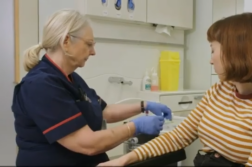TAMPA, Fla. (Ivanhoe Newswire) — About 50,000 Americans are diagnosed with Parkinson’s disease every year. It is a progressive disorder of the nervous system that can make daily activities difficult. But now researchers are trying out what looks like a breath strip of medicine that could make patients’ lives easier.
Playing the flute used to be easy for Helen Michaelson, but now Parkinson’s disease has robbed her of her rhythm. Just sitting still is a struggle.
Michaelson detailed, “When I get nervous or, ya know, I mean, my hands. It really affects everything.”
The former school band director and teacher of the year now takes medicine five times a day. But when it starts to wear off, these so called “off episodes” can be problematic.
“Sometimes you get so overwhelmed as far as being tired. You just can’t go anymore,” explained Michaelson.
A new kind of drug therapy is being tested that could help Michaelson with the “off episodes.” The drug is hidden in this blue strip. Patients put it under their tongue for two minutes. Medicine is absorbed into the mucus of the mouth, and then it goes into the bloodstream.
Robert Hauser, M.D., a professor of neurology at the University of South Florida, told Ivanhoe, “It’s called a dopamine agonist because it acts like dopamine in the brain.”
Dr. Hauser said the strip of medicine can rescue a patient stuck in a debilitating episode of immobility.
“It’s thought that the strip should provide benefit within 20 to 30 minutes. That’s still under evaluation and it’s thought that it may last 60 to 90 minutes. Again, that’s still under evaluation,” said Dr. Hauser.
A bridge until Michaelson’s next oral medication kicks in.
This new strip of medicine is not approved by the FDA yet. It’s in clinical trials right now and could be available to the public in two to three years.
Contributors to this news report include: Cyndy McGrath, Supervising Producer; Emily Maza Gleason, Field Producer; Milvionne Chery, Assistant Producer; Tony D’Astoli, Editor; Travis Bell, Videographer.
MEDICAL BREAKTHROUGHS
RESEARCH SUMMARY
TOPIC: Blue Strip Might Treat Parkinson’s
REPORT: MB #4153
BACKGROUND: Parkinson’s disease is a progressive disorder of the nervous system that affects movement for those who have it. About one million people in the US have Parkinson’s. It develops gradually and sometimes starts with a barely noticeable tremor in just one hand. A tremor may be the most well-known sign of Parkinson’s disease, but the disorder can also cause stiffness or slowing of movement. In the early stages of Parkinson’s disease, a person’s face may show little or no expression, or their arms may not swing when they walk. A person’s speech may also become soft or slurred. The symptoms for Parkinson’s disease worsen over time.
(Source: http://www.mayoclinic.org/diseases-conditions/parkinsons-disease/basics/definition/con-20028488)
TREATMENT: There is currently no cure for Parkinson’s disease. One of the current treatments for the disease is levodopa. A recent survey of 3,000 people from the Michael J. Fox Foundation found that 90 percent of people reported that they have at least one ‘off’ episode per day. During ‘off’ episodes a person cannot move and many cannot speak. This episode can happen at any time and anywhere and occurs when the treatment levodopa wears off. Sixty-five percent of the respondents had the ‘off’ episode last for two hours or more. Twenty percent of them had them last for more than four hours. A treatment currently for these off episodes is apomorphine, which is only available in injection form. Apomorphine is difficult for patients to self-administer and inconvenient for a caregiver to provide.
(Source: Robert Hauser, MD)
THERAPIES AND RESEARCH: A new treatment that researchers are exploring would deliver apomorphine through a thin film that’s similar to a breath strip that patients would place under their tongue. Studies have shown the strips helps control symptoms in most patients. The treatment could also provide relief to people who wake up experiencing slowness and stiffness. The breath strip-like treatment is not approved by the FDA, but is currently in a large Phase 3 study that is recruiting patients at 35 locations in 18 different states and in Ontario. Patients can go to clinicaltrial.gov to find a nearby site.
FOR MORE INFORMATION ON THIS REPORT, PLEASE CONTACT:
Scott Stachowiak
646-942-5630
Scott.stachowiak@russopartnersllc.com
If this story or any other Ivanhoe story has impacted your life or prompted you or someone you know to seek or change treatments, please let us know by contacting Marjorie Bekaert Thomas at mthomas@ivanhoe.com




